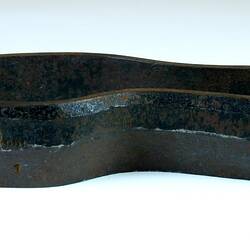Summary
This black/brown metal shoe press knife with its stamped inscriptions "69" and "7 7", was used by Stanio Fancoff to 'cookie-cut' his shoes' leather soles and uppers during the 1930s to1970s. This tool, along with many other press knives eliminated the use of hand knives. Being an instrument that saved production time and reduced production errors, the press knife was a integral instrument within the shoemaker's tool kit.
Stanio Ivanoff Fancoff was born in 1908 in Bojentsi, a small village in Bulgaria. At age 11, Stanio left home to learn the shoemaking trade. In 1929, he immigrated to Melbourne, settled in Fitzroy and began to work for the V.G. Zemancheff & Sons basket shoe factory in South Melbourne. In1936, he married Dorotea Georgi Touzou who had recently arrived in Australia. Around this time, Stanio set up his own shoemaking business from home, with Georgi, her cousin and sister weaving the shoes which he then assembled. Select shoe samples were then taken to Sydney and Tasmania for sale. In 1942, Georgi and Stanio moved to Broken Hill for Georgi's health; there daughter Nancy was born and Stanio set up a shoe shop/factory. In 1945, Georgi died and by 1950 Stanio and Nancy had moved to Adelaide where he again opened a shoemaking business and shop. He passed away in 1978, having been in the shoemaking business for 59 years. This collection documents his migration and working life experiences.
Physical Description
A punch tool formed by a metal strip that resembles a shoe. The press knife is of a two colour format, the upper darker black area is thicker while the lower lighter brown area has the sharpened blade as its edgeline. The metal surface area exhibits extensive signs of indentations and some ageing.
Significance
This collection is significant in documenting a small migrant business as well as the fashion of a particular period. It is well provenanced and charts the application of trade skills in a new country. It also illustrates the stages of hand shoe manufacture from the 1930s, demonstrating the enduring nature of the tools and patterns that were used.
More Information
-
Collecting Areas
-
Acquisition Information
Donation from Nancy Vasileff, 21 Mar 2007
-
Past Owner or User
-
Inscriptions
Text, Left Side, Midway point, Stamped: 69 Text, Left Side, Midway point, Stamped: 7 / 7 or possibly 1 / 1
-
Classification
-
Category
-
Discipline
-
Type of item
-
Overall Dimensions
82 mm (Width), 230 mm (Depth), 42 mm (Height)
-
References
R.A. Salaman, 'Dictionary of Leather-working Tools c.1700-1950 and Tools of Allied Trades,' London: George Allen and Unwin (Publishers) Ltd, 1986 [Section 2: Boot and Shoe Maker pp18-185]. John Peacock. 'Shoes, The Complete Sourcebook,' London:Thames & Hudson Ltd, 2005. NAA holds file (online) on Vasil George Zemancheff, Fancoff's employer
-
Keywords
Boot & Shoemaking, Bulgarian Communities, Bulgarian Immigration, Immigration, Small Businesses, Tools



